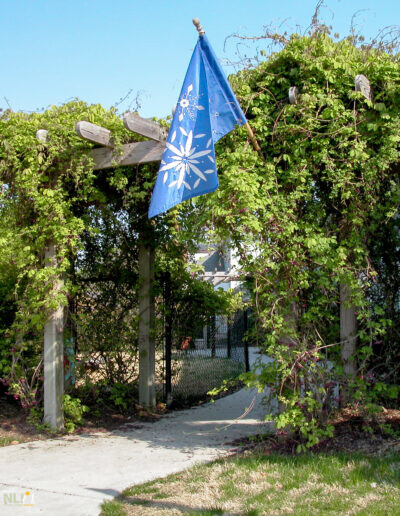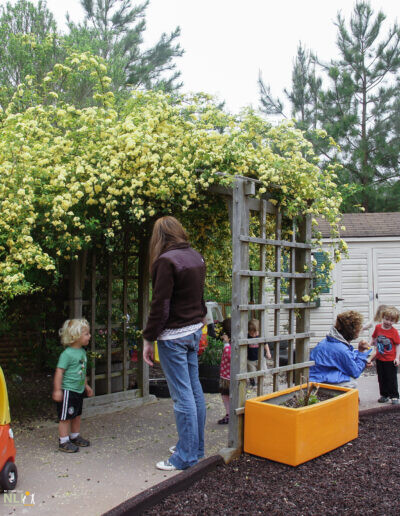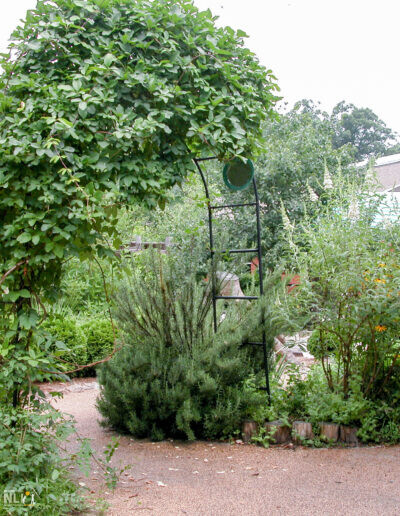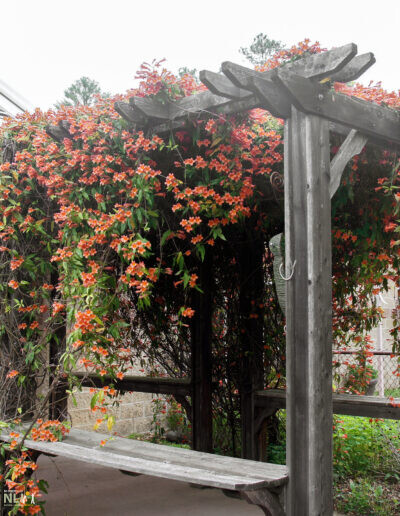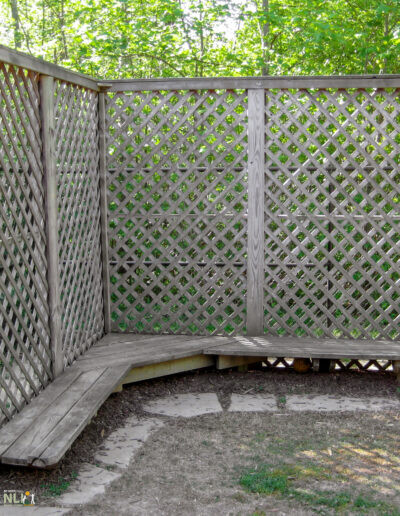12. Arbors, Pergolas, & Trellises
Arbors, pergolas, and trellises emerged centuries ago in Graeco-Roman gardens. Then as now they accentuate the third dimension, immersing users in nature by enveloping them with climbing plants. Constructed of wood or metal and naturalized with vines, these inexpensive, easily installed items serve similar purposes in outdoor play and learning spaces. Small versions can be purchased as kits.
DEFINITIONS
Arbors. Arbors are simple arched structures that may include side trellises to support vines on each side. Metal arbors may include continuous latticework from one side to the other.
Pergolas. Pergolas are colonnaded structures with wide cross-sections and larger dimensions than arbors. Posts support open, roof-like structures. Large footprints provide space for extravagant growth of climbing/cascading plants. Pergolas with circular or rectangular footprints offer shady outdoor classrooms and gathering spaces. Wood construction requires moderate skill, knowledge of carpentry, and some structural experience. Pergolas are larger and more elaborate than arbors and more challenging to install. Wood construction requires moderate skill, knowledge of carpentry, and some structural experience.
Trellises. Trellises provide a vertical, open lattice of wood or metal to support climbing plants.
PURPOSES
Arbors and pergolas can accent an entry, add interest to a pathway, create a transition space, enclose a setting, and provide shade. They offer attractive perching and nesting places for birds—animating the scene with color, song, and movement. Together with trellises, arbors and pergolas make “outdoor rooms” such as classrooms, gathering spaces, and secret hideaways. Combined with settings such as primary pathways, decks and stages, sensory impact can be reinforced using fragrant vines and colorful, wind-sensitive accouterments attached to the structure such as chimes, flags, banners, streamers, and windmills. Trellises can be attached to the sides of buildings or used as freestanding components to create green walls. They can subdivide space, allowing children to feel they are hiding, without blocking caregiver views. Make sure trellises are made from sturdy material that will last.
LOCATION
Arbors can serve as setting entrances and transitions. They can arch over and add spatial interest and naturalization to pathways. An arbor arched over a comfortable bench with trellises and climbing plants on three sides, becomes a “bower” – a quiet, shady resting place for children and caregivers, terminating a pathway or tucked into a corner.
Pergolas installed at building entrances create indoor-outdoor transitions. As freestanding structures they serve as outdoor classrooms or multipurpose, shady gathering spaces, where children’s work can be displayed and learning resources stored. Covered with fragrant climbers, grape vines, or gourds, pergolas provide settings that extend outdoor stays and learning potentials. A bird nest may appear overhead to the great excitement of children.
Trellises can be used as freestanding green “walls” that stimulate hiding and chase games.
For successful plant growth, always locate arbors, pergolas, and trellises in adequate sunlight.
MATERIALS
Arbors and Pergolas are typically built of wood, but can also be made from prefabricated metal. Use pressure treated wood for longevity and weather resistance, especially where the structure is in contact with the ground or below grade. Though more expensive, woods such as cedar and black locust are naturally rot resistant and recommended for longevity.
Trellises are typically made using wooden or prefabricated lattice material, but can be improvised using found and recycled materials, including chicken wire, bamboo, tightly tied string, old bike rims, bed frames, ladders—anything that plants can use to climb on! Ensure vines are adequately “trained” to climb by periodically weaving the plant through desired trellis material.
RECOMMENDED PLANTS
Below is a list of popular vines for naturalizing arbors, pergolas, and trellises. Annual vines need to be replanted each year, while perennial vines go dormant during the winter and bloom again the following season. Consider available sunlight and soil quality when choosing climbing vines. Runner beans are a popular choice because they grow quickly, have beautiful blooms, and add an edible component to the outdoors.
Annuals:
Lagenaria siceraria, Bottle gourd
Melothria scabra, Cucumber ‘Mexican sour gherkin’ (edible)
Phaseolus coccineus, Scarlet runner bean (edible)
Phaseolus vulgaris, Pole form beans ‘Blue Lake’ or ‘Red Noodle’ (edible)
Perennials:
Actinidia arguta, Hardy kiwi (edible)
Akebia quinata, Chocolate vine (chocolate scent)
Bignonia capreolata, Cross vine (prolific, red, trumpet flowers)
Lonicera sempervirens, Coral honeysuckle (attracts hummingbirds and butterflies)
Passiflora incarnata, Passion flower (exotic, intriguing flowers)
Trachelospermum asiaticum, Asian star jasmine
Trachelospermum jasminoides, Confederate star jasmine (incredible perfume)
Rosa banksiae, Lady Banks rose or Banks rose (thornless, hardy to USDA Zone 7, drought tolerant, vigorous growth, full sun to partial shade)
NOTE: Custom arbors and pergolas should be designed and built by licensed professionals. Sometimes, municipal construction permits may be required.
Reference
For a comprehensive, highly readable book on the subject, including construction details, see Pergolas, Arbours and Arches: Their History and How to Make Them, by Paul Edwards and Katherine Swift, 2001. London: Barn Elms.

